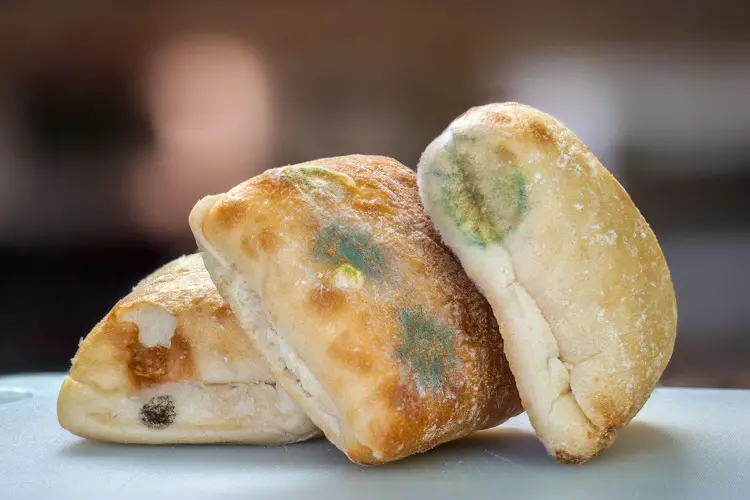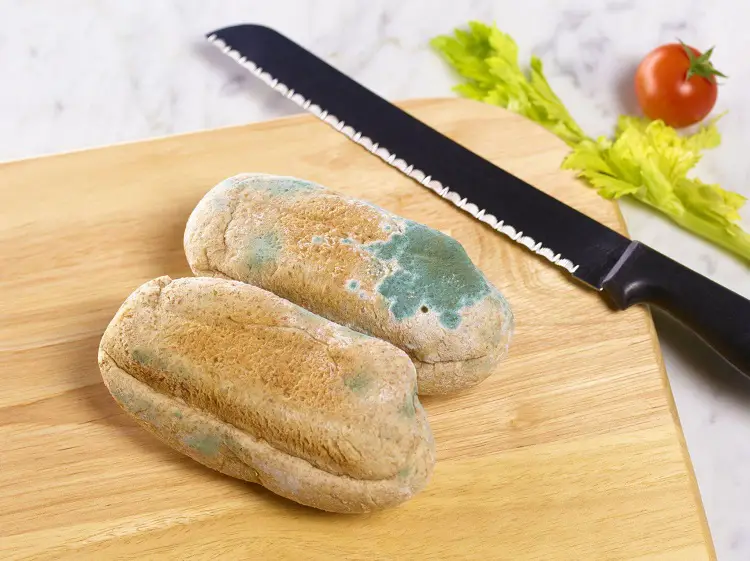Mold spores are the first physical signs of bad food.
They look very simple, but if ingested, they can lead to significant health complications, especially in babies, but there could be more.
Keeping an eye on what your baby eats is another way of ensuring child safety.
With how contaminated the environment is, the least you can do as a parent is to check that they don’t eat bad food that will make them sick.
Sadly, not all parents know when food has gone bad and what to do when their baby eats rotten food. So if you’re wondering what happens if a baby eats mold, the features in this article are for you.
Table of Contents
- What Is Mold?
- What Happens If a Baby Eats Mold Bread?
- Things to Avoid When Handling Moldy Foods
- How To Prevent Mold Growth On Food
- What To Do When A Baby Eats Mold?
- Can Mold Make Babies Sick?
- FAQs
- Conclusion
What Is Mold?
Mold is a type of fungal growth often seen on wet walls and stale food.
It has a grey-green appearance or mildew and often appears small and shallow, but it has deep roots that grow into the foods.
It thrives in humid, warm areas like kitchen walls, wet ceilings, and stale food.
Foods like bread, vegetables, juicy fruits, cooked foods, cheese, tomatoes, oranges, and other moist foods are more susceptible to fungal growth than dried foods or fruits.
Signs of Mold
The first signs of moldy food are:
Musty Odor
Mold grows deep into the foods they infest, causing a strange musty odor that permeates the food. You’ll likely perceive the odor before it shows any physical signs.
However, it’s not advisable to smell moldy foods as they can trigger allergies.
Dark Grey Spots
This is the most noticeable sign of moldy food. Dark grey-green spots appear randomly around the surface of the food. The spots are easy to take out and seem harmless, but they can be poisonous.
Dusty Grey-green Powder
This usually indicates that the mold is no longer growing. However, it is a sign that the food has been infected by bacteria and fungi and is no longer safe.
What Happens If a Baby Eats Mold Bread?

Vomiting, diarrhea, and upset tummy are common health complications babies face when they eat moldy foods.
It can get worse for babies with more sensitive tummies and lead to signs of fever.
Although not all molds are harmful, some have poisonous substances like mycotoxins which can lead to food poisoning.
Mold grows on exposed perishable foods, and with the thousands of bacteria and viruses in the environment, these foods easily get contaminated.
Contaminated foods decompose easily because of the presence of bacteria in them.
This means before those black spots appear on the food, it has already been contaminated with germs.
Also, mold grows slower than bacteria, which means foods with mold may also have bacterial growth, making the food more poisonous.
Things to Avoid When Handling Moldy Foods
Sniffing
Avoid sniffing foods with signs of mold on them. It can trigger allergic reactions and may lead to more complications.
Eating
Many think peeling off the mold from bread automatically makes the bread less harmful.
Mold may appear shallow, but it has roots that grow deep into the bread and spread throughout.
If you find the top and corners of the bread moldy, chances are that the entire load is contaminated and should be discarded.
Touching Without Washing Your Hands
It is better to wear gloves when touching moldy areas. However, if you have touched it with your bare hands, wash them immediately before touching other kitchen parts, especially food.
How To Prevent Mold Growth On Food
- Refrigerator perishable food immediately after you’re done with it.
- Use airtight bags or containers to store foods like bread or mold-prone foods you cannot refrigerate.
- Only buy large quantities of perishable foods if your power supply is stable.
- Do not preserve leftovers for long because some bacteria can survive cool temperatures.
- Store freshly cut fruits and vegetables in airtight bags and try to use them as soon as possible.
- Mold spreads quickly, so try to clean your fridge once a week to avoid contaminating other foods.
- Use mild detergent and vinegar to clean and sterilize the sections of the fridge.
- Wash and replace old kitchen towels and sponges regularly.
- Sundry kitchen towels and mops to kill mold spores
- Keep the kitchen dry and well-ventilated.
What To Do When A Baby Eats Mold?
As a parent, your first impulsive response when discovering that your baby has ingested mold will be panic.
This is very normal, considering the trouble you go through to ensure their safety. However, try as much as possible to stay calm. You’ll think and act better with a clear mind.
If you find your baby eating moldy food like bread, do these five things;
- Take the bread from your baby.
- Wet a clean towel and use it to wipe away his mouth. You can also use a paper towel, but a kitchen towel will work better.
- Give him some water to rinse his mouth and also drink.
- Do not try to induce any vomiting to prevent choking your child.
- Take him to the hospital or call any health center for further instructions.
Can Mold Make Babies Sick?
When your baby inhales air contaminated with mold spores, it can trigger some reactions like sneezing, wheezing, runny nose, and other breathing problems like asthma and, in extreme cases, fever.
Mold doesn’t grow on food alone but can also be inhaled in the air.
If your baby ingested or inhaled mold, he’ll show some of these signs that sometimes include mild tummy upset, vomiting, and diarrhea which aren’t extreme and don’t require any medical attention.
Mold doesn’t cause severe health issues and requires medical attention, but you can call your doctor if the signs persist.
When to visit the doctor
If your baby has ingested mold, it isn’t necessarily something you should be worried about.
It is essential to monitor babies closely, even if they do not show any symptoms. Babies with mold allergies, asthma, or weakened immune systems are more likely to become ill.
If your baby feels unwell after eating mold, contact your baby’s doctor immediately. If your baby is having difficulty breathing, do not hesitate to seek medical attention immediately.
Read Also: How To Get Mold Out Of Fabric in a Stroller
FAQs
Why does bread mold?
Mold is a microscopic fungus that breaks down organic matter. Like seeds, mold multiplies by producing tiny spores that survive harsh environments.
Mold spores take root and multiply when they land on surfaces that contain moisture and nutrients.
Mold can also grow on any organic material, most especially on food such as bread. Mold thrives well on bread because it contains abundant carbohydrates and moisture.
Several factors, such as bread type, moisture content, and storage temperature, can dictate mold growth on bread.
Can I get food poisoning from moldy bread?
Your baby may experience an allergic reaction if it is allergic to mold.
This can cause various symptoms like vomiting, diarrhea, and respiratory distress. Mold allergies can also lead to asthma attacks, which can be extremely dangerous for babies.
Symptoms of foodborne illnesses include vomiting and diarrhea, which can result in dehydration.
Moldy food can also cause foodborne illnesses since bacteria are often present where mold grows.
Is bread okay if I remove the moldy bits?
Many people try to recover moldy food by cutting off the bad areas, but this is not recommended for bread.
As bread is soft and porous, it is impossible to know how far the mold has spread.
By contrast, you can still eat firm vegetables, cured meats, and hard cheeses after removing the moldy portion.
Read Also: What happens when you accidentally drink mold while pregnant
Conclusion
Having mold on food and around the house is unattractive and dangerous, especially if you have toddlers.
As much as you try to keep babies safe, you can’t guarantee they will not ingest moldy foods if it’s within their reach.
If your toddler has eaten mold and you’re wondering what happens if a baby eats mold, you don’t have to worry too much as we have you covered on what to do when your baby eats mold.
